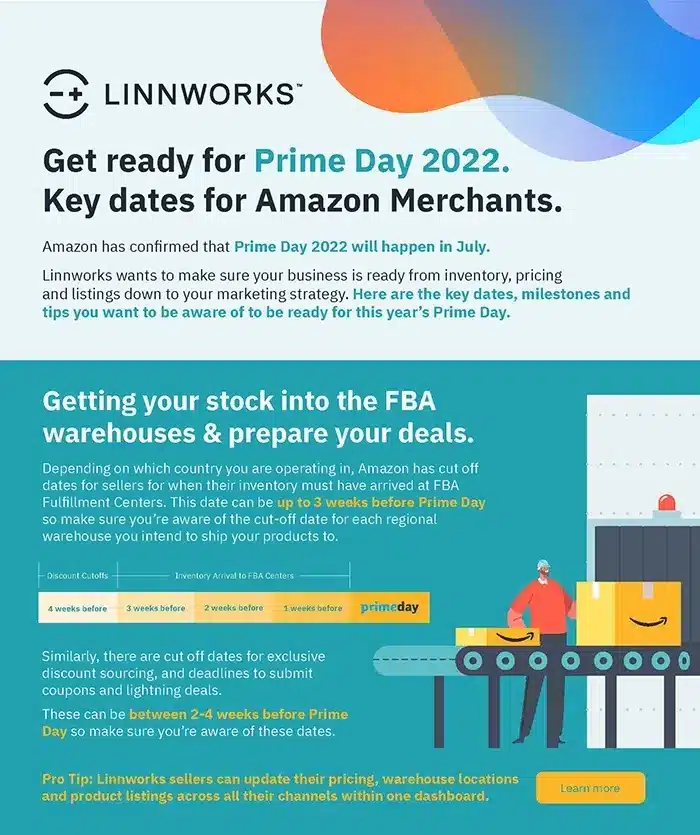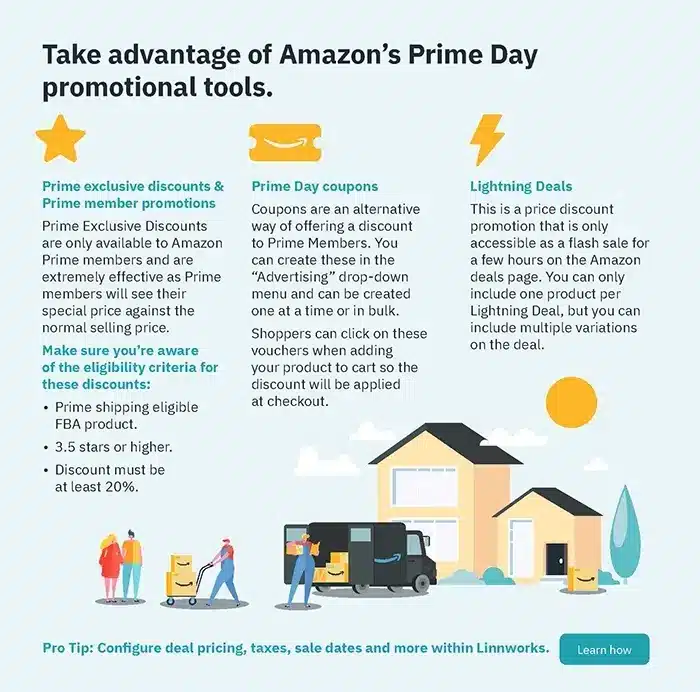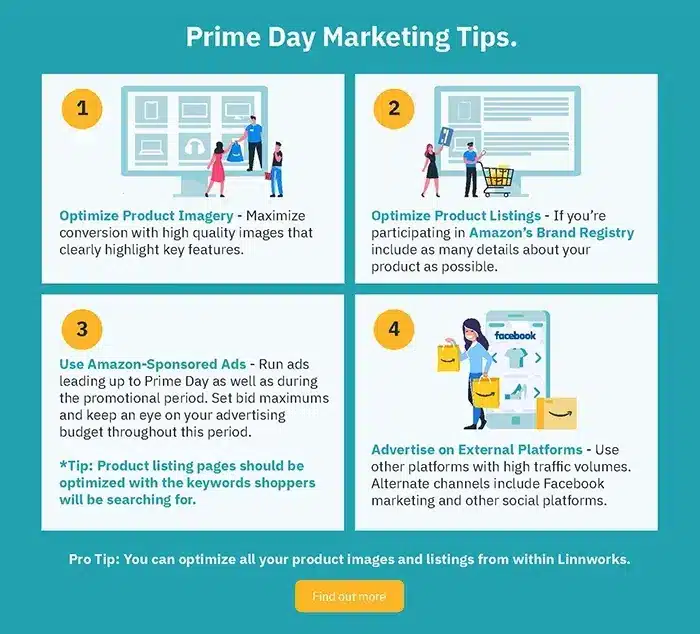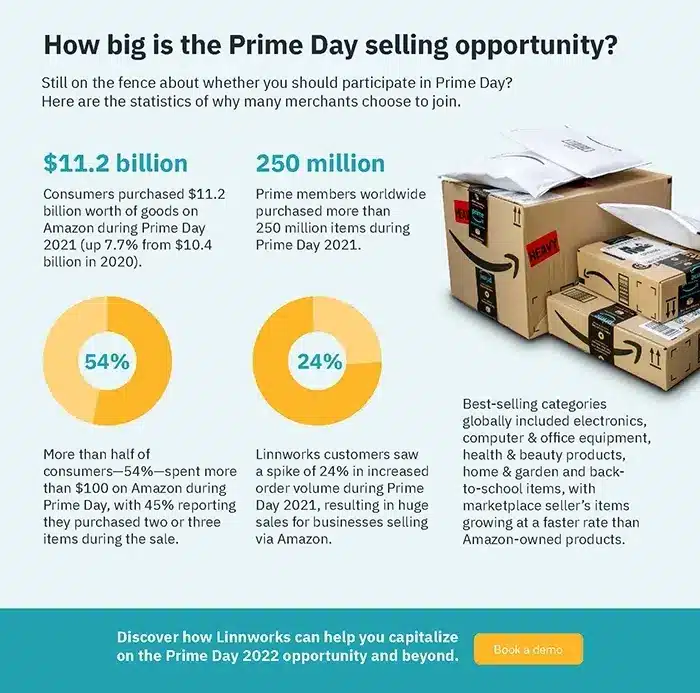How to prepare for Amazon Prime Day
Consumers are experiencing “always-on” shopping.
They can shop at any time and any place, on their terms. With the removal of barriers comes an increasing emphasis on a frictionless, convenient shopping experience. According to Linnworks research, 78 percent of consumers say they value convenience more than before pandemic restrictions and 45 percent are more influenced by convenience than price.
It’s no surprise that consumers are engaged in Amazon Prime Day. In 2021, sales on Amazon Prime Day increased 7.7% compared to sales in 2020 — that’s $11.2 billion in sales in 2021, up from $10.4 billion in 2020.
And Amazon is one of the top marketplaces in commerce — it is one of the two dominant marketplaces in terms of GMV (gross merchandise value), according to Linnworks platform data. When it comes to overall Marketplace GMV, there was a significant increase in Q1 2021 (37%), compared to Q1 2020, according to Linnworks data.
Businesses should be prepared to capitalize on Prime Day. Here’s what you need to know.
When is Amazon Prime Day?
Amazon Prime Day is set to take place July 12 and 13.
Prime Day usually occurs on a different day every year and sometimes spans multiple days, like this year.
What is Amazon Prime Day?
As the name suggests, Amazon Prime Day is a one-day global shopping event created solely for Amazon Prime members, delivering huge discounts and bargains, similar to the sort you would expect from Black Friday and Cyber Monday events.
Specifically, Amazon Prime Day provides huge opportunities for sellers, so it is definitely something you should be leveraging.
What’s the Big Deal?
Prime Day is not just another online sales event. Since it began, it has gradually expanded in length and scope, with more and more sellers pining to get a cut of the pie.
As you might expect, it’s more relevant than ever.
How can sellers prepare for Amazon Prime Day?
If you do it right, Prime Day can do wonders for your sales numbers. First, figure out the pricing and marketing strategy that will be most attractive to your customers.
Prepare your discounts.
Before you get caught up in all the marketing and promotion, don’t forget the true purpose of the day: helping your customers save money. Customers flock to Prime Day in search of a deal. It’s up to you to make an offer they can’t refuse.
It all comes down to price. Although you might already have a stable, trusted pricing strategy, it’s not necessarily going to work for Prime Day. It’s all about offering something better than normal so that customers will be make a purchase.
When it comes to Prime Day, you usually run into three different types of deals.
Reserved for the most popular products, spotlight deals are the first ones presented to consumers. They usually involve a high demand product being sold at a ridiculously low price.
Of course, it doesn’t make sense to sell off your entire inventory this way. Most sellers sell a limited amount of a product through spotlight deals, ending the offer once that limit has been reached.
Lightning deals are where Amazon’s UX plays a massive role and customers are presented with a concrete visual of how fast a product is selling. Amazon displays the percentage of these products that have been sold or are being held by other customers, as well as how long shoppers have left to get the deal.
These types of deals are usually only promoted for a few hours at a time. That being said, scarcity is a big part of the appeal. Customers love to feel like they are getting something special, especially when the deal will be off the table in minutes.
Finally, there are standard Prime savings and deals, which are offered for the entirety of the event.
Think about what products would be most appealing for Prime Day, and which deal would be most appropriate for each product. It’s wise to not only take into account how attractive a product seems, but how much your business can handle selling it for such a significant discount.
Make sure you can handle the surge.
If everything goes to plan, Prime Day will be one of your business’s most rewarding days of the year. You need to be prepared to deal with the workload and inventory management demands to come with such a flood of sales.
Look into 3PL Options
Whatever your plan is, make sure you have enough hands to efficiently get your products to your customers’ doors.
If you use Fulfillment by Amazon (FBA), Amazon will store, pick, pack and ship your products.
However, if you fulfill orders on your own, you need to make sure you’re prepared.
Perhaps this means opening more warehouse shifts than usual, offering bonuses or other incentives for the added workload. Be sure to communicate with your shipping partner in advance about the expected surge in orders so they know to be prepared. You want to make sure there are no delays and mistakes so that your customers have a positive experiences. You want to make sure you’re providing a seamless post-purchase experience no matter what time of year it is.
Another option is to partner with a 3PL to provide you with multiple fulfillment center locations. A 3PL is when a business outsources the distribution, warehousing, and/or fulfillment of its products.
Consider automation
It may be a good time to work automation into your commerce operations process.
An inventory management system can streamline a lot of your business processes, including your relationships with your suppliers, partners or shipping carriers. Especially when you are selling on multiple channels, the task of efficient and timely fulfillment can be too much to handle. If you are selling products on other marketplaces, automation can ensure inventory accuracy across all marketplaces, all the time, especially on Prime Day.
Craft strategies to avoid losses and maximize engagement
While it’s tempting to wow customers with a discount that is barely profitable, you don’t want to leave Prime Day empty-handed.
Another thing you want to avoid is stock outs, which can be a major barrier to order fulfillment during a sales event. Demand will be much higher than usual, so increasing your safety stock thresholds in anticipation for Prime Day is highly recommended. Keep a close eye on your inventory well before the day comes.
Now that we’ve talked about avoiding stock outs, it’s time to think about the fun part: increasing sales.
A good way to get a variety of your products into customers’ hands is through bundles. While you should give them the option to buy products on their own, offering special deals for products bought together is a great way to get customers to buy products they hadn’t considered before. If these bundles and savings are presented as a reward, you will reap the added benefit of a positive customer experience.
Make a marketing push, with Amazon’s help.
If you’re offering massive Prime Day savings, let your customers know. Talk about the event as much as possible on your main marketing channels. You should have a strategy in place for social media, reminding your customers what they are missing if they sit Prime Day out.
Consider paying for promoted ads that fit right into the feeds of users in your target audience. That way your messaging will extend beyond the customers who are already loyal enough to follow you.
Mailing lists are a huge part of promotional events like this. If you subscribe to an engagement suite, think critically about how to most effectively target specific segments of your audience. When your emails arrive in your subscribers’ inboxes, craft a subject line and body that makes it abundantly clear what’s in it for them. Let them know when to seek out your most attractive promotions and how much they can potentially save. On Prime Day, the discounts usually speak for themselves.
The best thing about Prime Day is that Amazon takes on a lot of the marketing responsibility. Of course, they won’t craft marketing campaigns on your behalf, but they do offer a few tools you can use to draw more customers in.
Much like promoted ads on social media, for a fee your product can become a “sponsored product.” This means your product will be more effectively visible when shoppers browse or search for relevant keywords.
This makes sense for deals that you expect to be particularly alluring to consumers. If you go this route, think about what keywords best suit your product, or let Amazon automatically do it for you based on consumer behavior data.
The principles of search engine optimization (SEO) are just as relevant on Prime Day. Everything about how you present your product — the pictures you use, the keywords you tag, the description you write — has the potential to attract and deter customers. Be as intentional as you can, optimizing your strategy to fit the design and user experience of the Prime Day interface.
Every effort to sell more on Amazon Prime Day is well worth it.



